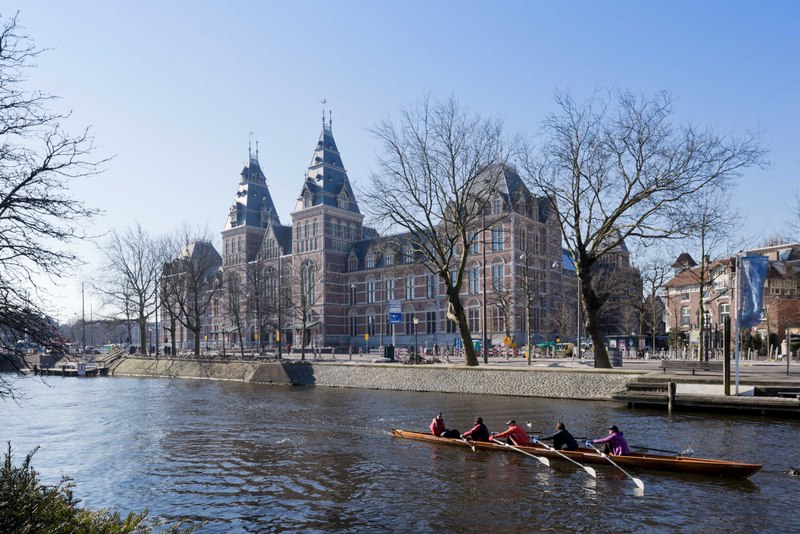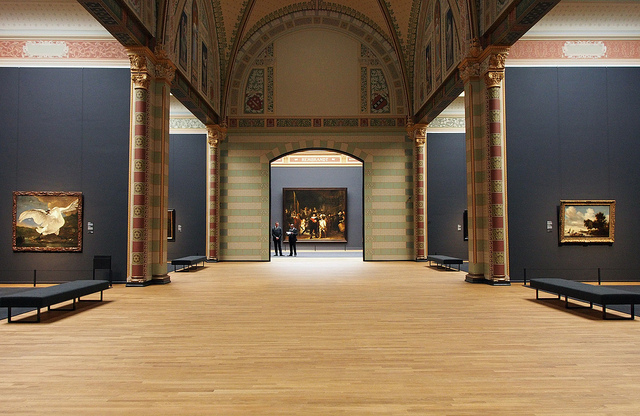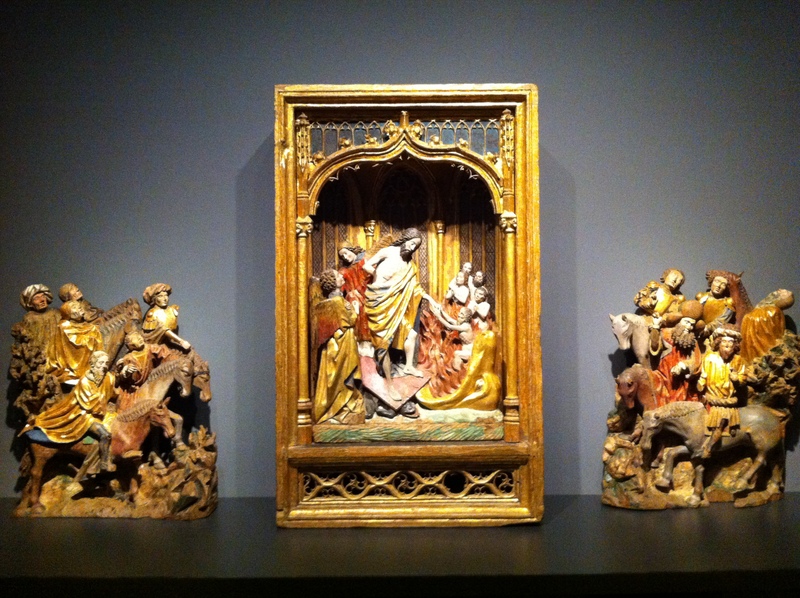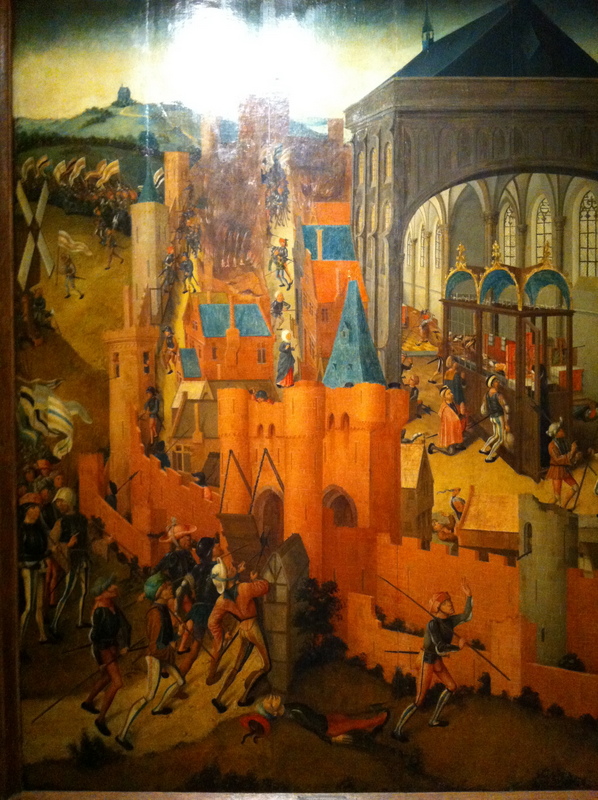The New Rijksmuseum in Amsterdam
In April, the Rijksmuseum in Amsterdam was reopened to the public, after almost ten years of restoration and rebuilding. What started out in 2004 as a four-year enterprise to liberate the landmark building, built in 1885 by the Dutch Neo-Gothic architect Pierre Cuypers, from its later additions, turned out to be a lengthy and very expensive story of endless delays and complications. This led to heated discussions in the national media on several issues. The Spanish architects of the refurbishment, Cruz y Ortiz, were especially astonished about the debate on the use of the public passage under the museum by cyclists, which complicated the issue of where the entrance to the museum should be located. Although officially the cyclists’ lobby seemed to have won, and the passage is now open to traffic, it remains closed during peak hours when the queues at the entrance block the passage.
In the meantime, the restoration of the building was accompanied by another debate in the Dutch political and museum landscape on the need for a national history museum. This project, initiated by a socialist politician, intended to create an overview of Dutch history especially for school classes; it was intended to increase the knowledge and understanding of important moments of national history, which, according to common opinion, was not given enough attention in primary or secondary school curricula. After the initial political decision to create this historical museum ex novo, debates broke loose over where in the country this new institution should be built, and what kind of presentation it should offer: from old-fashioned chronology to a post-modernist thematic approach. After long deliberations it was decided that this museum cumschool trip-destination should be built in the east of the country, in order to spread museums geographically over the country; subsequently, its construction was delayed by–yet again–financial complications. When the financial crisis led to severe cuts in the cultural sector in 2010, the penultimate Dutch government decided to abolish the project entirely. Already prior to that moment, the Rijksmuseum (along with some other museums in the Netherlands) stated that they, in fact, already represented this ‘national’ historic museum.
This claim was based on the circumstance that when it was opened in 1885, the Rijksmuseum combined under one roof three museums; one in Amsterdam, which contained the art historical treasures from the Dutch State and the City of Amsterdam, the latter of which had been enriched in 1854 with a gift by the rich banker Adriaan van der Hoop; another museum in nearby Haarlem that had mainly been dedicated to contemporary (thus nineteenth-century) art; and a third museum that was primarily a collection of historical objects in The Hague, the Dutch Museum for History and Art (Nederlandsch Museum voor Geschiedenis en Kunst). To these three museums were added several other, smaller collections, both from private individuals and institutions; for example, a collection of plaster casts after antique statues was relocated to the Rijksmuseum, from various archaeological collections. With this array of rather diverse objects, the new Rijksmuseum set out to combine art and history, even though during its entire existence prior to 2004, the departments of art and of history in the Rijksmuseum had been autonomous, having their respective parts of the building to themselves, and with their own curators and directors. In stating its historical role to combine art and history, the new Rijksmuseum idealised and simplified its own past.
The restoration of the old building that began in 2004 was intended to be a return to its pristine state, the design by Cuypers. Thus, Cruz y Ortiz and an entire equipe of architects and restorers set out to liberate the original building from later additions, mainly in its interior, opening up the original courtyards which had been built in during the 1960s. Now these courtyards have been given glass roofs–following an architectural trend in the museum world set in by the British Museum. They also uncovered a large part of the late-nineteenth-century decorative schemes in the circulation and exhibition spaces. The latter project was, however, not simply a return to the original situation, but a recreation; for instance, the colours of the majority of wall decorations were toned down, so as not to interfere too much with the paintings. In other spaces, the walls and sometimes ceilings were painted in diverse shades of dark grey, covering the original decorative masonry work of glazed and unglazed brick. Surely, the decision to paint over these elements or to restrict their brightness does not fit Pierre Cuypers’ original intentions. It does, however, make an aesthetically satisfactory solution, although the rather dark shades of grey applied to the walls in the Gallery of Honour (on the first floor, with the most renowned seventeenth-century paintings) and on the ground floor (where the pre-1600 objects are on display) might rather soon become old-fashioned. Moreover, this choice of colours leads to a scheme of lighting intending to spotlight the object in predominantly dark surroundings; this play of contrasts is certainly a trend in the international museum world. Although it does support the palette in most portraits and history scenes, with landscapes it goes less well, creating in some instances an effect of dullness in blue skies and green foliage.
But whatever the visitor will think of these aesthetic choices, the main discourse in the Netherlands prior to the reopening was the range of objects on display, and how these objects would illustrate the story of Dutch culture throughout the history of the Netherlands. As this had neither had been the case when the museum opened in 1885, nor had this been realized in the twentieth century (as the departments of Art and History remained separate entities up to 2004), it forced the museum to reinvent itself completely in the process of renovation. The reopening of the museum on April 13 this year was therefore, for many Dutch colleagues from the museum world and academia, an event. How would objects of history and art be combined, and what kind of ‘national’ story would that kind of selection show? The main issues would predictably concern the period before the Golden Age–the sections of medieval and Renaissance–and the modern period, as twentieth-century art had never been acquired by the Rijksmuseum. The curiosity in academic circles was heightened by the fact that internal discussions between historians and art historians occasionally filtered through outside the museum walls. To what extent could and should aesthetic criteria be applied to the choice of historical objects? And, most important, where would the ‘History of the Netherlands’ start, according to the museum’s curators?
When entering the new exhibition spaces, the first pleasant surprise is that the Dutch national story is not limited to the geographical confines of the Seven United Provinces, and neither does it confine itself to the territory of present-day Netherlands. The ground floor, dedicated to the period of the Middle Ages to the late sixteenth century, actually crosses the borders to the Germanic regions to the east, and to the Flemish (and occasionally French) provinces to the south, demonstrating the exchange between the various artistic centres. For example, a larger altarpiece by the Master of Joachim and Anna, made in Brabant around 1470 is flanked by a beautiful sculpted portable altar from Mechelen or Brussels, from around 1540, a mid-fourteenth-century stone sculpture of Mary with Christ Child from Normandy, and mostly French ivory work (see images). The accompanying texts, however, focus to a large extent upon the Christian meaning of these works and far less on the issue of style, attribution or geographic identity; it is clear that the display has been made with the average visitor in mind, not with an overall question of Dutch history or identity, or the issue of how to determine the respective styles.
However, the further one progresses through the ground floor galleries–rather dark now as a result of the ash-grey colour applied to the walls and (comparatively low) vaults–the more that a division is made between ‘Dutch’ and ‘foreign’ art. While the first two corner rooms display Italian and French works–for example, illustrating the International Gothic style, with a wonderful Mary Magdalene by Carlo Crivelli and a superb candlestick by Andrea del Verrocchio of 1468 (see image)–this ‘sandwiching’ of national and international becomes less and less conspicuous. In the last room, dedicated to pre-1600 painting, there are works by Dutch painters who travelled to Italy, but the Italian works themselves are no longer present. The international perspective disappears almost completely on the main (second) floor of the museum, dedicated to the Golden Age. Here, we only find one room with Flemish paintings– mainly Jordaens–and one room with Caravaggisti painters, while in both rooms the message to the visitor is that a lot of inspiration was drawn by Dutch painters from these foreign examples, but no hint of what was actually happening beyond the Netherlands.
Historically, this choice to skip non-Dutch art does not surprise as the holdings of non-Dutch art in the Rijksmuseum were traditional small. This notwithstanding, the curator appointed for ‘foreign’ art at the Rijksmuseum some ten years ago, Duncan Bull, did his best to increase this part of the collection, for example, acquiring an seascape by Claude Lorrain to pair with the Dutch Italianate landscape painters such as Both. Now he sees his efforts to increase this part of the collection made largely invisible on the main floor of the museum. What is left there is the wonderful array of paintings from the Dutch Golden Age, sometimes flanked with illustrative objects from its history. For example, the room which contains a set of marine paintings and especially the rather particular pen-paintings of sea vessels by Willem van der Velde the Younger also displays a wonderful model of a war vessel, a portrait of Admiral Michiel de Ruyter by Ferdinand Bol–also admittedly beautiful–and a set of rifles in an Indonesian wooden stand (see image) (however, the accompanying text focuses on Admiral Tromp, and leaves undiscussed the colonial background of this object). All these objects do combine very well, but they do not, in any sense, convey more than a very general story of warfare and victory.
Apart from the limited additions of foreign and applied art and historical objects, the main floor of the Rijksmuseum offers few surprises to those familiar with the old situation; here we find the Gallery of Honour (see image above) with paintings by the masters of the Golden Age—Vermeer, Jan Steen, Frans Hals and of course Rembrandt—visually culminating in the Nightwatch. Of course, the canon of Dutch art we find here is in some respects different from what was on display twenty years ago, but the inclusion of painters in a more classicizing style like Gerard de Lairesse had already taken place in the late 1990s, not long before the closure of (most of) the museum (see image). Also the first floor, dedicated to eighteenth- and nineteenth-century art and culture presents the visitor familiar with the ‘old’ Rijksmuseum with few surprises; a particular but rather unobtrusive shift should be noted from painting to furniture, porcelain and other kinds of objects in the eighteenth-century department. It underlines what has been noted in other reviews of the Rijksmuseum, namely that the production of painting in the Netherlands could not keep up with the international developments, and fell to a regional level. This, however, is an assumption that could be contested with quite a number of wonderful portraits of the museum’s collections that used to be on display in the former study collection. That these are not as grand as the seventeenth-century portraits might be related to the change of style and taste in domestic furnishings and public decorations, but this is not the same as a decrease in artistic quality.
A lot of public attention, however, has been focused on the two sections in the new Rijksmuseum dedicated to the twentieth-century. The museum formerly had (almost) no holdings in this field, and therefore was obliged to acquire new objects or receive loans from other museums in order to create a satisfactory display. There are two main problems with this ‘new’ department in the museum. The first is a design issue. This new department is spread over two separate sets of rooms that are not interconnected. In order to go from the first part to the second, one has to take the stairs to the lower floor, cross the central hall, and go up the stairs again. It leads to two completely different sections, of which the first—pre-1940—only shows the avant-garde artistic movements, but almost nothing of the contextual, historic situation (except for an airplane that illustrates the quest for novelty and modernism in a small part of Dutch society). Furthermore, the visitor here finds a number of works by Mondrian, that cannot match the quality of Mondrian works on show in the Municipal Museum in The Hague, or even the (recently reopened) Stedelijk Museum, which is only 500 meters away from the Rijksmuseum. The second part of the display of twentieth-century Dutch art and culture is more interesting, as here choices have been made that enlighten the visitor more generally about Dutch culture after 1945. The group of Dutch painters belonging to the international CoBrA movement, feminist art of the 1970s, and architectural drawings and graphic designs definitely provide more of an idea how the same kind of modernist urge led to changes in Dutch society and visual culture that also affected the genera culture to a large extent.
One very simple but effective choice in the Rijksmuseum is its policy with regard to audiovisual techniques. Most of the moving images on show in the department of twentieth-century art and culture (for example the film I’m too sad to tell you by Bas Jan Ader) have no sound. In general, the visitor is invited to look at the objects and not focus on interactive screens or pay attention to audiovisual information. It is therefore a pity that the texts accompanying the objects often add little to what we can see; or do not relate to the image at all. One example of the latter is a curious painting, The Siege of Rhenen, an attack on the city of Rhenen in 1499 (see image). The text informs the visitor in a few lines about the historic event, but does not elucidate at all what is illustrated in the picture (where we see the inhabitants of the town seeking refuge in the church, in front of a reliquary, it seems) or what kind of function it might have had. This follows a general pattern throughout the museum of the information being at a rather basic level, leaving it to the more knowledgeable visitor to try and construct a cultural and artistic history on a more abstract level.
Notwithstanding the claims of the museum itself, the Rijksmuseum has not really become a place where art, history and culture are shown in a coherent way and with equal attention to their specific meanings. The main choice seems to have been dictated by the aesthetic qualities of each object, made predominantly from an art-historical point of view. The reformulation of the Rijksmuseum in terms of a ‘National treasury of art and history’ has clearly favoured the art historical objects that constitute the main trajectory of the display. Where historical objects have been chosen irrespective of their visual attraction, they have been reduced to mere illustrations to the works of art. There is therefore little attempt to value these historical objects in their own right, or to question what was excluded from view in, for example, official portraiture or cityscapes.
This focus on art leads to a museum that poses no questions about the Dutch past. It represents national pride in historic feats and, to a much greater extent, in its art historical masterpieces. This might fit the historical mission of the museum, but it certainly does not reflect the display from the time of Cuypers when the museum opened in 1885. For the twenty-first century museum visitor, such a historical view might be considered uncritical and old-fashioned. The art historical focus on the object does not elucidate how Dutch culture was part of a wider exchange within the context of Europe or the rest of the world. In contrast to most ‘national’ museums of art such as the Louvre, the National Gallery in London and the Metropolitan Museum, it reduces the Rijksmuseum to a rather monothematic display of Dutch art, while in the context of national history museums, there is a conspicuous lack of critical reflection. In the new Rijksmuseum in Amsterdam, one is invited to admire the great painters of the Golden Age, not to understand which international historical issues determined the production of all these works of art, or in which international context Dutch painters came to define a particular style.
© Arnold Witte, University of Amsterdam, 2013
Website: https://www.rijksmuseum.nl/




